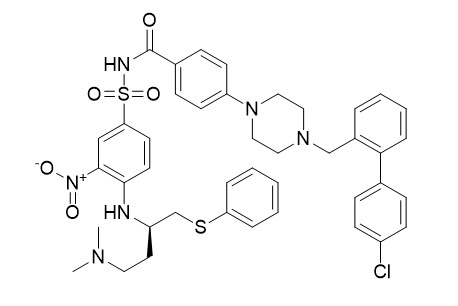ABT-737
ABT-737 is a BH3 mimetic inhibitor of Bcl-xL, Bcl-2 and Bcl-w with EC50 of 78.7 nM, 30.3 nM and 197.8 nM in cell-free assays, respectively; no inhibition observed against Mcl-1, Bcl-B or Bfl-1. ABT-737 induces mitochondrial pathway apoptosis and mitophagy.
Inquire / Order:
manager@chemfaces.com
Technical Inquiries:
service@chemfaces.com
Tel:
+86-27-84237783
Fax:
+86-27-84254680
Address:
1 Building, No. 83, CheCheng Rd., Wuhan Economic and Technological Development Zone, Wuhan, Hubei 430056, PRC
Providing storage is as stated on the product vial and the vial is kept tightly sealed, the product can be stored for up to
24 months(2-8C).
Wherever possible, you should prepare and use solutions on the same day. However, if you need to make up stock solutions in advance, we recommend that you store the solution as aliquots in tightly sealed vials at -20C. Generally, these will be useable for up to two weeks. Before use, and prior to opening the vial we recommend that you allow your product to equilibrate to room temperature for at least 1 hour.
Need more advice on solubility, usage and handling? Please email to: service@chemfaces.com
The packaging of the product may have turned upside down during transportation, resulting in the natural compounds adhering to the neck or cap of the vial. take the vial out of its packaging and gently shake to let the compounds fall to the bottom of the vial. for liquid products, centrifuge at 200-500 RPM to gather the liquid at the bottom of the vial. try to avoid loss or contamination during handling.
Molecules.2016, 21(6)
Malaysian Journal of Analytical Sciences2023, 27(4):840-848.
Anat Rec2018, 24264
Foods.2020, 9(10):1348.
Molecules.2021, 26(6):1635.
Biotechnology and Bioprocess Engineering2024, 29:1048-1060.
Molecules.2019, 24(16):E3003
Evid Based Complement Alternat Med.2021, 2021:5585692.
J Chromatogr Sci.2015, 53(5):824-9
J AOAC Int.2024, qsae028.
Related and Featured Products
Cancer Cell,2006 Nov;10(5):389-99.
The BH3 mimetic ABT-737 targets selective Bcl-2 proteins and efficiently induces apoptosis via Bak/Bax if Mcl-1 is neutralized.[Pubmed:
17097561]
Since apoptosis is impaired in malignant cells overexpressing prosurvival Bcl-2 proteins, drugs mimicking their natural antagonists, BH3-only proteins, might overcome chemoresistance.
METHODS AND RESULTS:
Of seven putative BH3 mimetics tested, only ABT-737 triggered Bax/Bak-mediated apoptosis. Despite its high affinity for Bcl-2, Bcl-x(L), and Bcl-w, many cell types proved refractory to ABT-737. We show that this resistance reflects ABT-737's inability to target another prosurvival relative, Mcl-1. Downregulation of Mcl-1 by several strategies conferred sensitivity to ABT-737. Furthermore, enforced Mcl-1 expression in a mouse lymphoma model conferred resistance. In contrast, cells overexpressing Bcl-2 remained highly sensitive to ABT-737.
CONCLUSIONS:
Hence, ABT-737 should prove efficacious in tumors with low Mcl-1 levels, or when combined with agents that inactivate Mcl-1, even to treat those tumors that overexpress Bcl-2.
Cancer Lett,2012 Apr 28;317(2):218-25.
Targeting Bcl-2 family proteins in adult T-cell leukemia/lymphoma: in vitro and in vivo effects of the novel Bcl-2 family inhibitor ABT-737.[Pubmed:
22138435]
METHODS AND RESULTS:
Adult T-cell leukemia/lymphoma (ATLL) is a peripheral T-cell malignancy caused by human T-lymphotropic virus type I (HTLV-1). ABT-737, a small molecule inhibitor of Bcl-2, Bcl-X(L), and Bcl-w, significantly induced apoptosis in HTLV-1 infected T-cell lines as well as in fresh ATLL cells, and synergistically enhanced the cytotoxicity and apoptosis induced by conventional cytotoxic drugs. Moreover, ABT-737 significantly inhibited the in vivo tumor growth of an ATLL mouse model.
CONCLUSIONS:
These results suggest that the use of an agent targeting anti-apoptotic bcl-2 family proteins, either alone or in combination with other conventional drugs, represents a novel promising approach for ATLL.
Cancer Res,2007 Feb 1;67(3):1176-83.
Influence of Bcl-2 family members on the cellular response of small-cell lung cancer cell lines to ABT-737.[Pubmed:
17283153]
Cell lines: SCLC cell lines NCI-H889, NCI-H1963, NCI-H1417, NCI-H146, NCI-187, DMS79, NCI-1048, NCI-H82, NCI-H196, H69AR, and DMS114
Concentrations: 0.001-10 μM
Incubation Time: 48 hours
Method:
SCLC cells are treated for 48 hours in 96-well tissue culture plates in a total volume of 100 μL tissue culture medium supplemented with 10% human serum. Viable cells are determined using the MTS assay.
Cancer Cell, 2006 Nov;10(5):375-88.
Mechanisms of apoptosis sensitivity and resistance to the BH3 mimetic ABT-737 in acute myeloid leukemia.[Pubmed:
17097560]
Animal Models:Scid mice injected with Luc-expressing FD/ΔRaf-1:ER cells
Dosages:20 and 30 mg/kg
Administration: For intraperitoneal (i.p.) every day



